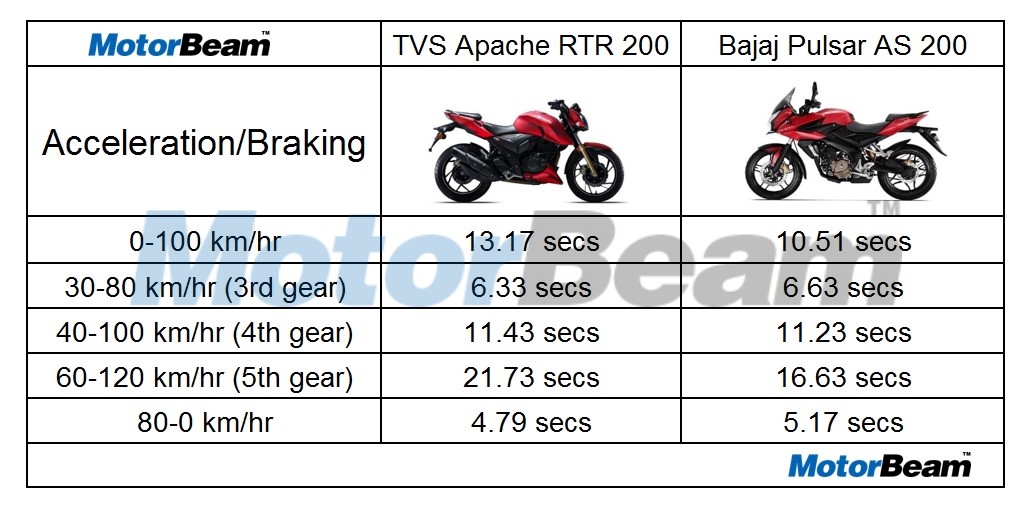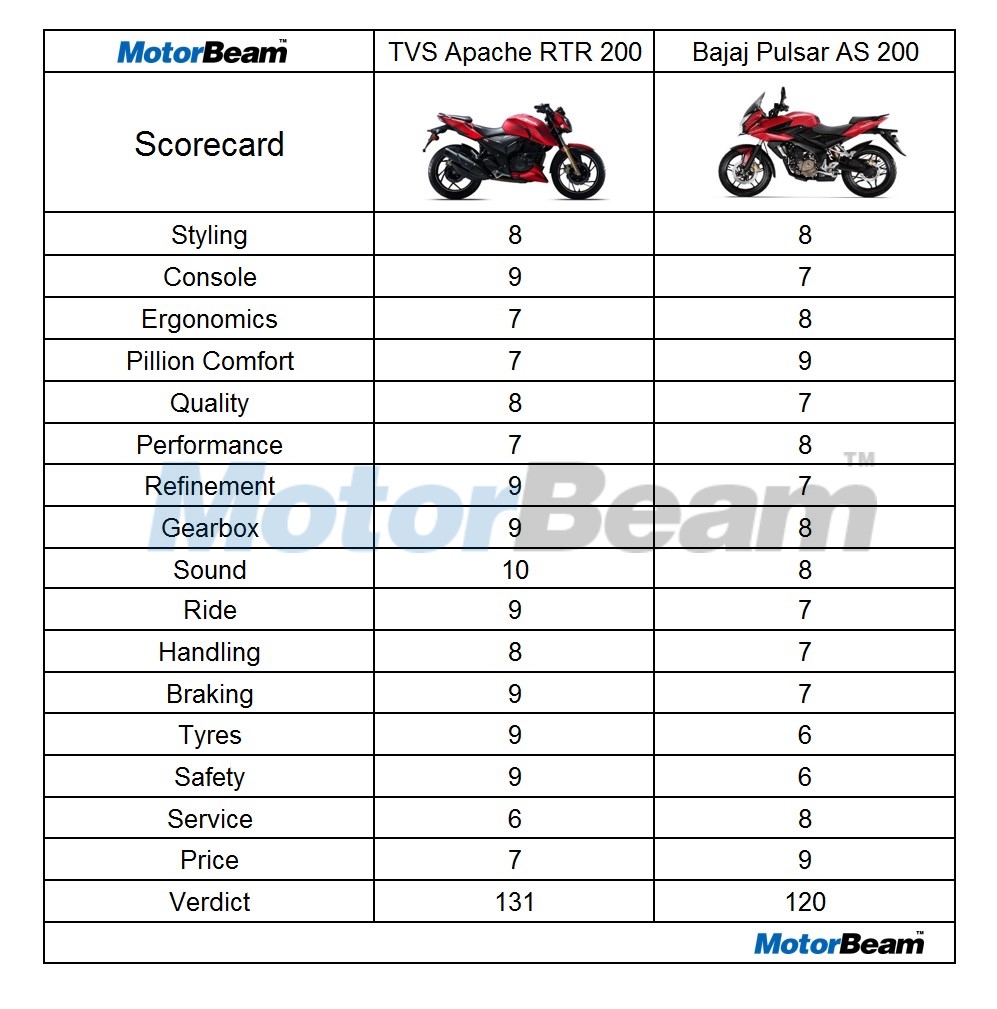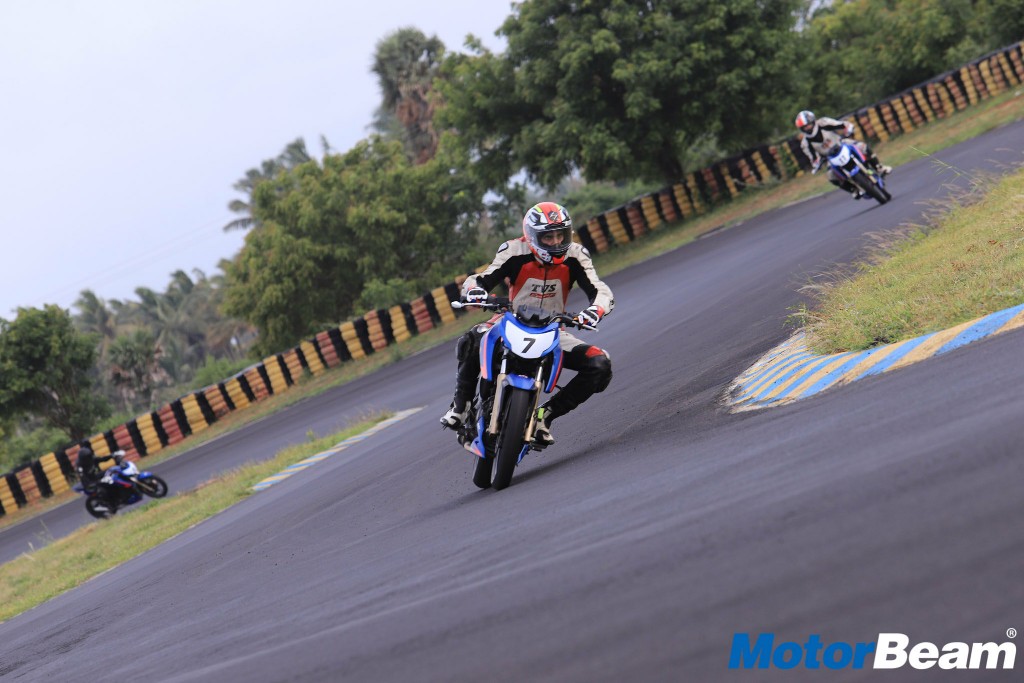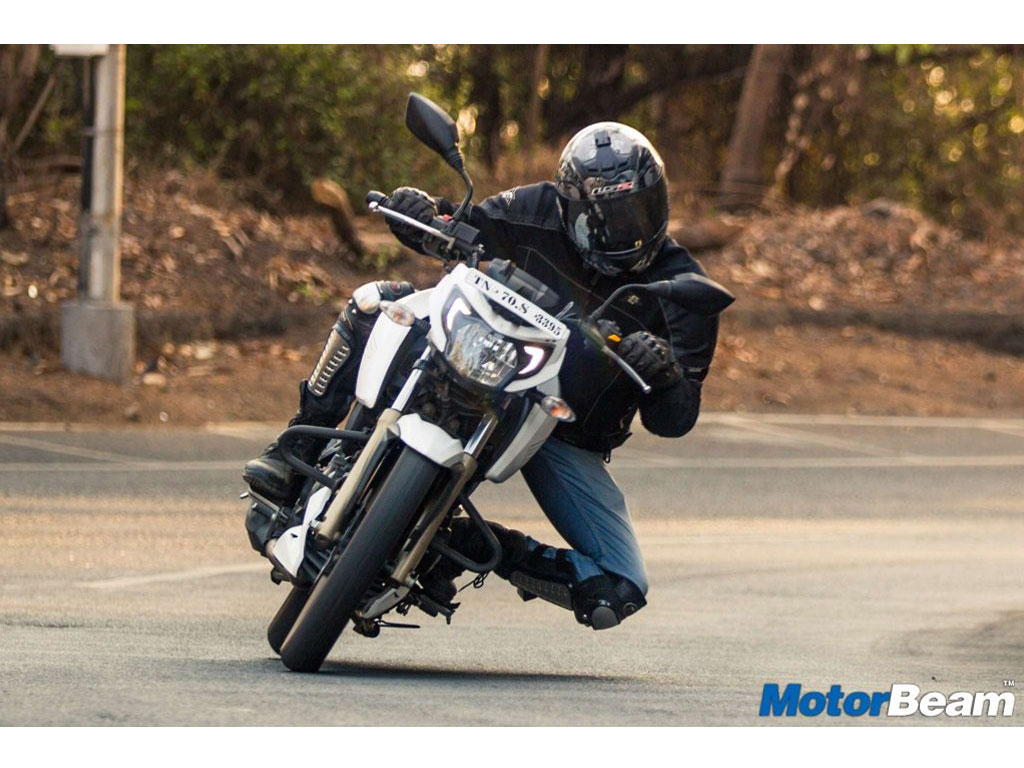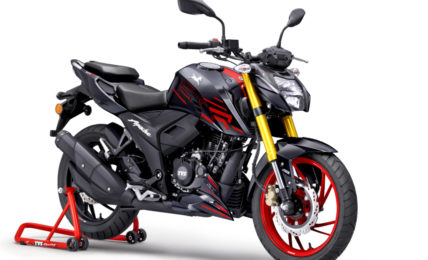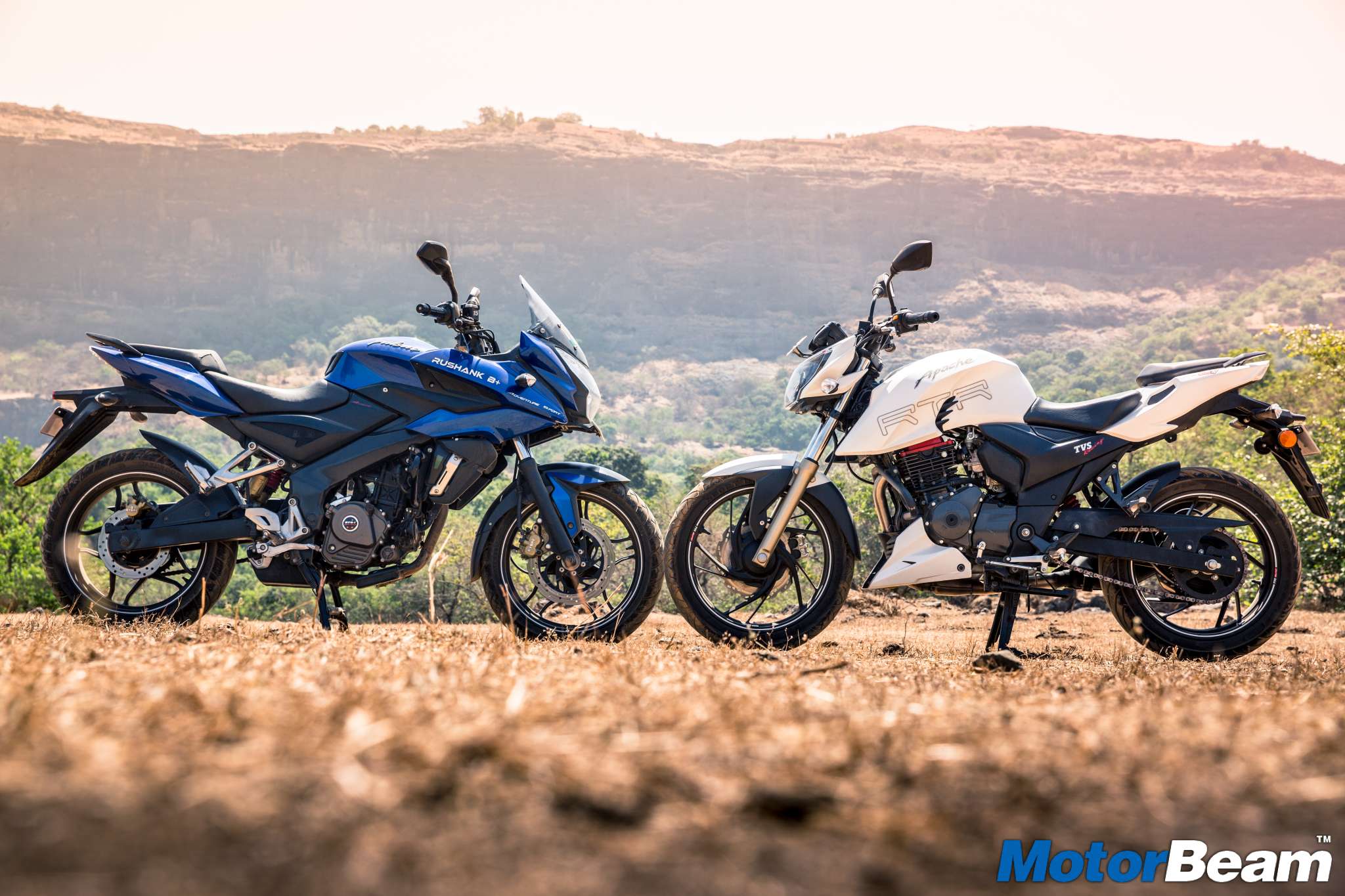
Shootout: TVS Apache 200 vs Pulsar AS 200
Shootout No. 157
Price OTR Mumbai: Rs. 1.09 – 1.15 lakhs (TVS Apache 200 carb non-ABS), Rs. 1.09 lakhs (Pulsar AS 200)
These 200cc Indian bikes are similarly priced but are as different as chalk and cheese
Everyone loves competition and if the competition is neck to neck, the fight happens to be brutal. To demonstrate, market leadership in the 200cc segment has been owned by Bajaj for a few years now and it has been unchallenged as the Pulsar range of motorcycles kept the bar high until TVS launched its new flagship model, the Apache with a 200cc mill ready to take on the Pulsar’s reign. Yet again with a really long name, the TVS Apache RTR 200 4V is here to compete with the Bajaj Pulsar AS 200. Which of these two should be the pick?
Motor Quest: Bajaj introduced the new range of Pulsars with the 200cc, triple-spark plug, liquid-cooled engine in 2012 which was called the Pulsar 200 NS. Bajaj then added two more motorcycles, the AS 200 and RS 200 in the year 2015. Now in the year 2016, TVS has come up with some competition, introducing a new flagship model of its Apache line-up, having a 200cc engine and naming it the TVS Apache RTR 200 4V.
Both the bikes look similar yet there is a lot to differentiate
Styling – First glance at the bikes and they are a much grown up version of their predecessors. The Pulsar AS 200 seems slightly old while the Apache 200 looks really fresh. The bulkiness of the Pulsar AS 200 comes from the front semi-fairing which seems to be borrowed from the Pulsar 220. And definitely worked upon with a modern approach. The Apache 200 however has the structure from the Apache 180 while everything has an update in design and styling. Comparing both the bikes, the Apache looks sharper while the Pulsar looks smooth and healthy.
An edgy naked design stands next to a raised semi-faired machine
The Apache 200 looks muscular while the Pulsar AS 200 looks robust
The Apache 200 seems to have been on steroids as every body panel is edgy and has a solid build to it. The Pulsar’s semi-fairing makes it look bold while the Apache compensates with a belly cowl and an angry headlamp with integrated DRLs. Both the motorcycles have 10-spoke alloy wheels while it’s the TVS which looks more attractive. Both again feature split seats but at the end, the batman shaped grab-rail on the Apache grabs the attention. And not to forget, the double barrel exhaust gives the Apache 200 more appeal over the concealed underbelly exhaust on the Pulsar AS 200.
The analog-digital meter from the Pulsar 200 NS does the job here
Instrument Cluster and Switchgear – The instrument cluster is something that a rider looks at every time when on the saddle. For the Pulsar, there’s no drastic change as the console is just picked up from the Pulsar 200 NS and put into the semi-fairing. The console stays an analog-digital unit. While the same on the Apache is completely new. It is a complete digital unit with loads of features. The white back-light presents an upmarket feel to the instrument cluster. The console on the Apache is much more advanced and flashes a text ‘Wear your gear’ every time the bike is switched on.
Completely new all-digital console is put onto the TVS Apache 200
The console on the Apache features a top-speed recorder, lap-time recorder and a shortest time recorder as the additional features. Rest of the conventional data is already present in it. The console of the Apache is better than the Pulsar but the illuminated switchgear on the Pulsar is better. The Apache 200 gets same switchgear from the Apache 180. The switchgear on the Apache does get a piano finish but the quality isn’t top notch. At night, the back-lit switchgear on the Pulsar looks significant and beautiful too.
Apache is more comfortable for shorter riders where Pulsar is suitable for taller riders
Ergonomics – The ergonomics of the Apache 200 is based completely on a street-fighter. While the Pulsar AS 200 has touring oriented ergonomics. Though both the bikes feature clip-on handles, the Pulsar is a bit more relaxed than the Apache. The clip-ons are higher, also the footpegs are more comfortable and less cramped. The Apache has similar clip-ons but the raised footpegs give a slightly cramped and committed riding posture in comparison to the Pulsar AS 200. The semi-fairing helps cut through wind-blast on the Pulsar AS 200 while the naked design of the Apache 200 provides a good view to the rider while it is more prone to wind-blast.
The ergonomics for both these motorcycles is quite similar
The 800 mm seat height of the Apache 200 is more comfortable for shorter riders than the 810 mm seat height of the Pulsar AS 200. The Apache seems to have cramped posture for the legs but shorter riders find it easier and more manageable. The Pulsar stays compliant to all kind of riders but it’s the hard seat that leads to some discomfort. The pillion seat on the other hand is wide and more comfortable on the Pulsar. The Apache 200 has a better ground clearance and it is also 5 kgs lighter than the Pulsar AS 200.
The machines have ample performance to have fun with
Performance – Considering the performance, the Pulsar AS 200 beats the Apache 200 hands down on paper as well as on the road. But both the bikes have adequate power if considered individually. As both the motorcycles produce more than 20 BHP of power and a slight over 18 Nm of torque while weighing close to 150 kgs, the power to weight ratio of both the machines feels adequate. It is the nature of the engine which brings the variation. While the Apache has a strong mid-range and a peppy low-end, the Pulsar has all the punch in its top-end, making it much appropriate for the highway.
The Apache 200 is comparatively lighter than the Pulsar AS 200
Dissimilar nature of engine is the key aspect between both these bikes
The engine on the Pulsar AS 200 is more advanced as it gets a radiator for liquid-cooling and THREE spark plugs, while the Apache 200 follows as it gets an oil-cooler and a single spark plug. Both the bikes boast of 4-valves and that results to similar mileage figures. The engine on the Apache 200 is smoother than the Pulsar AS 200. Vibrations are felt on the Apache 200 only when pushed hard while the Pulsar vibrates all along its power-band. The engine on the Pulsar AS 200 feels harsh.
The gearbox is different on both the motorcycles too. The 5-speed gearbox on the Apache 200 has a rather short ratio than the 6-speed gearbox on the Pulsar AS 200. The gear shifts on the Apache 200 are also much smoother than that on the Pulsar AS 200. Similarly the clutch is lighter and the Apache feels more apt to the rider. While the Pulsar has taller gears, making lesser shifts and a good usable RPM range while riding in the straights. The Apache 200 doesn’t mind hitting the 12,000 RPM mark repeatedly while the Pulsar locks itself at 11,500 RPM. The sound from the Pulsar remains throaty while the exhaust note of the double-barrel exhaust on the Apache 200 is mind blowing.
The Pulsar AS 200 has better high speed stability
Riding Dynamics – Underneath, the Pulsar AS 200 is a perimeter frame while the Apache 200 does the job with a double-cradle frame. Though the perimeter frame is superior to the double-cradle frame, the Apache 200 handles much better than the Pulsar AS 200. Cornering is a gem on the Apache while the Pulsar feels more home on the straights. The Pulsar has the advantage of the semi-fairing over the naked Apache, giving it the edge for high speed cruising and stability. The suspension on the Apache 200 is softly sprung while it’s stiffer on the Pulsar, resulting in a better ride quality on the Apache.
Apache 200 is a gem in corners, takes on the Pulsar AS 200 very well
Practicality is no more than the accepted form of comfort with performance that is thrilling
The optional Pirelli tyres on the Apache 200 are more grippy than the Eurogrip tyres on the Pulsar. The Apache hence offers more confidence than the Pulsar while cornering. Even while braking, the grippy tyres help a lot and the braking feedback from Apache 200 is amazing. The brakes on the Pulsar As 200 are just fine while compared to the ones on the Apache 200. An optional ABS on offer gives a fair leverage to the Apache 200 in safety.
From the similar genre, yet distinctive from each other
Verdict – The Bajaj Pulsar AS 200 is more value for money and comes with better hardware but it’s the Apache 200 that gets more safety, better tyres and happens to be more practical than the Bajaj motorcycle. The Pulsar is a proper performer but the Apache offers more refinement and suitable dynamics giving it an edge over the AS 200. The Pulsar is a good machine, more suited for people looking out just for outright performance with touring capabilities but it’s the Apache 200 that beats the Pulsar as it’s a better product here. The TVS Apache 200 4V is definitely our pick.
Testers’ Note:
Performance vs Practicality, choice is difficult but impeccable
Picture Editing: Sri Manikanta Achanta
Further Reading –
TVS Apache 200 Review
TVS Apache 200 Video Review
Bajaj Pulsar AS 200 Review
TVS Apache 200 vs Pulsar AS 200 Video
Catch All The Latest Videos, Subscribe To


